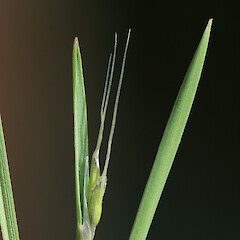Amphibromus fluitans
Common name
water brome
Synonyms
Amphibromus gracilis P.Morris of Australia is now regarded as a synonym of A. fluitans.
Family
Poaceae
Flora category
Vascular – Native
Endemic taxon
No
Endemic genus
No
Endemic family
No
Structural class
Grasses
NVS code
The National Vegetation Survey (NVS) Databank is a physical archive and electronic databank containing records of over 94,000 vegetation survey plots - including data from over 19,000 permanent plots. NVS maintains a standard set of species code abbreviations that correspond to standard scientific plant names from the Ngä Tipu o Aotearoa - New Zealand Plants database.
AMPFLU
Chromosome number
2n = 42
Current conservation status
The conservation status of all known New Zealand vascular plant taxa at the rank of species and below were reassessed in 2017 using the New Zealand Threat Classification System (NZTCS) – more information about this can be found on the NZTCS website. This report includes a statistical summary and brief notes on changes since 2012 and replaces all previous NZTCS lists for vascular plants.
Please note, threat classifications are often suggested by authors when publications fall between NZTCS assessment periods – an interim threat classification status has not been assessed by the NZTCS panel.
- Conservation status of New Zealand indigenous vascular plants, 2017 . 2018. Peter J. de Lange, Jeremy R. Rolfe, John W. Barkla, Shannel P. Courtney, Paul D. Champion, Leon R. Perrie, Sarah M. Beadel, Kerry A. Ford, Ilse Breitwieser, Ines Schönberger, Rowan Hindmarsh-Walls, Peter B. Heenan and Kate Ladley. Department of Conservation. Source: NZTCS and licensed by DOC for reuse under the Creative Commons Attribution 4.0 International licence.
2017 | Threatened – Nationally Vulnerable | Qualifiers: DP, TO
Previous conservation statuses
2012 | Threatened – Nationally Vulnerable | Qualifiers: EF, TO
2009 | Threatened – Nationally Endangered | Qualifiers: EF, TO
2004 | Threatened – Nationally Endangered
Distribution
Indigenous. New Zealand, North and South Islands. In the North Island It is known from Ninety Mile Beach and Karikari Peninsula to Paekakariki and Lake Wairarapa. In the South Island known only from Maher’s Swamp, near Punakaiki and from Lake Tekapo. Present in Australia where it is very uncommon. The largest populations of the species seem to be at the Waihora and Arohaki lagoons, at Lake Rerewhakaaitu in wetlands on the north eastern and eastern margin of Lake Wairarapa.
Habitat
Coastal to montane in moderately fertile, seasonally dry wetlands or along the edges of shallow lakes and lagoons.
Wetland plant indicator status rating
Information derived from the revised national wetland plant list prepared to assist councils in delineating and monitoring wetlands (Clarkson et al., 2021 Manaaki Whenua – Landcare Research Contract Report LC3975 for Hawke’s Bay Regional Council). The national plant list categorises plants by the extent to which they are found in wetlands and not ‘drylands’. The indicator status ratings are OBL (obligate wetland), FACW (facultative wetland), FAC (facultative), FACU (facultative upland), and UPL (obligate upland). If you have suggestions for the Wetland Indicator Status Rating, please contact: [Enable JavaScript to view protected content]
OBL: Obligate Wetland
Almost always is a hydrophyte, rarely in uplands (non-wetlands).
Detailed description
Somewhat flaccid to weakly tufted, stoloniferous, semi-aquatic grass, forming circular grey-green mats 70–400 × 150 mm on muddy ground (up to 400 mm tall when growing up through surrounding vegetation). Culms decumbent, rooting at lower nodes, erect or floating above. Leaf-sheath papery, smooth or scabrid, often wholly scabrid toward culm apex. Ligule 1.5–5 mm, long-tapered, acute, initially entire, becoming lacerate. Leaf-blade 50–125 × 0.6–3 mm, grey-green, flat or inrolled, upper surface somewhat scabrid, shallowly ribbed, undersides notably more scabrid and prominently ribbed, apex acute. Culm internodes mostly smooth, rarely scabrid below nodes. Panicle 65–13 mm, erect, initially enclosed below by uppermost leaf-sheath, at fruiting often expanding entirely above leaves; branches and pedicels scabrid. Spikelets 15–25 mm, 3–6-flowered, pale green. Glumes unequal, glabrous, obtuse margins ciliate-scabrid; lower 2–3 mm, 1-nerved, narrowly lanceolate, upper 2–4 mm, 3-nerved, ovate-lanceolate. Lemma 4–5.5 mm, 7-nerved, firm, green, margin rather wide, hyaline, minutely scabrid or hairy; lemma lobes 2, obtuse; awn 7–18 mm, straight, arising from lemma midpoint. Palea < lemma, keels stiffly ciliate, interkeel glabrous. Seeds 1.5–2 × 0.5–0.7 mm.
Manaaki Whenua Online Interactive Key
Similar taxa
Sterile specimens of creeping bent (Agrostis stolonifera L.) are most similar and often grows in the same habitat. Creeping bent has fleshy leaves and the leaf blade tends to be wider than the sheath. Kneed foxtail (Alopecurus genicuatus L.) is also similar in the vegetative state but it is larger and coarser. Sweetgrasses (Glyceria species) have long thin (often blue-green coloured) leaves with cross-veinlets and they tend to float on water.
Flowering
September - May (dependent on water levels)
Fruiting
September-July (dependent on water levels)
Life cycle
Florets are dispersed by wind (Thorsen et al., 2009).
Propagation technique
Easily grown from fresh seed and the division of rooted pieces. Can be grown in dry ground but prefers damp soil. Good in a pot, and an unusual and attractive grass for a pond or slow flowing stream.
Threats
Habitat loss through wetland drainage, stock grazing and competition from weeds.
Etymology
fluitans: From the Greek fluito (floating)
Extra information
Story in in Trilepidea issue 30 (May 2006).
Attribution
Description modified from Edgar and Connon (2000).
References and further reading
Edgar E, Connor HE. 2000. Flora of New Zealand. Vol. V. Grasses. Christchurch, Manaaki Whenua Press. 650 p.
Gardner, R. 2000. Notes towards an excursion Flora.Amphibromus fluitans (Poaceae). Auckland Botanical Society Journal 55: 54–55.
Ogle, C.C. 1987. A rarely seen native grass Amphibromus fluitans. Wellington Botanical Society Bulletin 43: 29–32.
Thorsen MJ, Dickinson KJM, Seddon PJ. 2009. Seed dispersal systems in the New Zealand flora. Perspectives in Plant Ecology, Evolution and Systematics 11: 285–309.

















